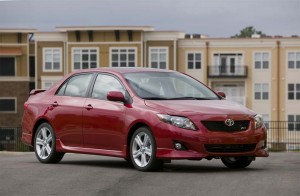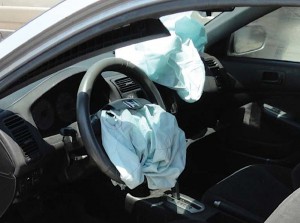The already record recall of faulty Takata airbags has grown even larger, Toyota Motor Corp. announcing today it will target nearly 6 million more of the devices, including some used in an earlier recall.
The announcement comes just days after it was revealed that an 11th American was killed in a crash due to faulty Takata airbag inflators that can rupture and spew shrapnel into the passenger compartment following a crash. At least four more people are known to have been killed in similar crashes overseas.
U.S. safety regulators have so far ordered recalls covering an estimated 60 million or more vehicles using Takata airbags. The figure has now grown to about 100 million worldwide, according to transportation authorities.
(For more on the latest Takata airbag death, Click Here.)
The latest recall by Toyota covers a wide range of vehicles sold in various markets around the world, including the Hilux pickup, the Yaris subcompact and the Corolla, the latter one of Toyota’s best-selling vehicles. Both driver and passenger-side airbags installed between May 2000 and November 2001, as well as from April 2006 to December 2014 are covered by the latest recall order affecting 5.8 million vehicles.
The latest move is unusually broad in that it affects not only major auto markets like Europe, China and Japan, but Africa, the Mideast and South America.
And it underscores the problems that both regulators and automakers face keeping up with the problems posed by Takata airbags. About 20,000 of the vehicles involved in the latest recall were already covered by an earlier, 2010 service action and must now have their airbags replaced for a second time.
In fact, that is likely to be the case with hundreds of thousands, and perhaps millions, more vehicles, including many operating in the U.S. Due to the breadth of the ongoing Takata problem, some automakers are struggling to find replacement airbag inflators and are replacing old ones with newer parts that will eventually be subject to recall. A few companies have continued to install suspect Takata airbags in brand new vehicles, as well.
(NHTSA reports showing hundreds of Takata airbags rupturing in testing. For more, Click Here.)
While such moves are controversial, data generated by the National Highway Traffic Safety Administration show that Takata inflators are generally considered safe until they begin to age. By the time they are a dozen years old, however, there is as much as a 50% chance that they will malfunction.
Exactly why has been a subject of intense debate. It is generally accepted that the Takata inflators are particularly sensitive to being used in hot, high humidity environments, such as Southern Florida. But an industry-funded research effort also pointed to the basic design of the devices, singling out the explosive ammonium nitrate used to inflate Takata’s bags when triggered by a crash. It appears prone to breaking down over time.
Takata is now providing bags with a chemical agent designed to absorb humidity. The Japanese supplier also has said it will switch to an alternate propellant.
But the company’s future is in jeopardy due to the costs associated with the ongoing recalls and the legal actions it faces, including consumer lawsuits and government penalties. Takata is in the midst of seeking new investors or a possible buyer.
(Takata CEO resigns under fire. For more, Click Here.)



